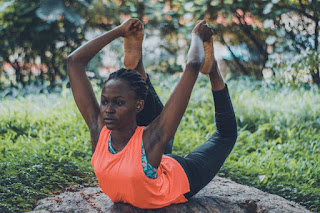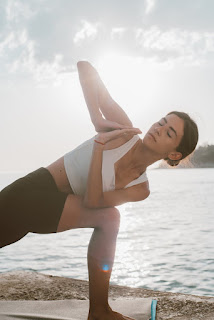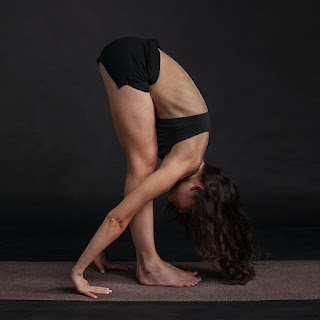Yoga on the Go: Staying Flexible During Travel
Yoga on the Go: Staying Flexible During Travel

Maintaining a consistent yoga practice can be challenging, especially for frequent travelers with unpredictable schedules and varying environments. Whether you’re on the road every week or trying to keep up your practice during a vacation, finding time for yoga practices from various traditions can seem nearly impossible. This guide aims to provide you with motivation and practical tips to stay committed to your practice, no matter where life takes you.
Consider a yoga retreat as a potential travel option to immerse yourself in yoga practice while exploring new destinations.
Building a Strong Yoga Practice
Establishing a personal yoga routine is essential for maintaining your practice outside of your daily schedule. Ashtanga yoga, a classical form of yoga, can be part of a strong personal routine. Whether you follow YouTube videos, listen to podcasts, or attend in-person classes, having a baseline for your practice helps you adapt and continue your routine while traveling. Bhakti yoga and karma yoga, significant types of yoga described in the Bhagavad Gita, can also enrich one’s practice. Here are a few common travel scenarios we’ll focus on:
- Road Trips
- Traditional Vacations and business trips
- Camping
- Cruises
Road trips: Stretching on the Open Road
Road trips offer unique opportunities and challenges for maintaining a yoga practice. The flexibility of your schedule allows for spontaneous yoga sessions, but long hours in the car can leave you feeling stiff and fatigued. Here are some tips to integrate yoga into your road trips:
Stretch Breaks: Plan regular stops to stretch and do a few yoga poses. Even 5-10 minutes of stretching can rejuvenate your body and mind.
Car Yoga: If you’re a passenger, you can do some gentle seated stretches and breathing exercises to stay relaxed.
Portable Props: Bring a travel yoga mat, resistance bands, or a yoga strap. These can be easily packed and used at rest stops or parks along your route.
Online Classes: Use yoga apps or download videos before your trip to follow along whenever you have a break.
From my personal experience, maintaining a regular yoga practice on a road trip involves setting up a dedicated time for your session, either before you start driving for the day or after you’ve finished for the day. Doing both can be challenging, so I opt for a morning session to connect and center myself before hitting the road. This helps prevent physical discomfort from sitting in the car for hours and sets a positive mindset for the trip.
Whether you’re the driver or a “passenger princess,” taking the time to meditate on your needs and set some intentions for the drive can enhance the overall experience and help you maintain your yoga routine.

Yoga on Vacation: Blissful Balance at a Yoga Retreat
Traditional vacations and business trips can disrupt your usual yoga routine, but they also present opportunities to practice in new environments. Traveling to a new area can be an amazing time to try new things, even with your yoga practice. If you don’t regularly attend classes, consider finding a studio near where you’re staying. Experiencing a local yoga class can provide a fresh perspective and invigorate your practice.
If you’re traveling to a place with beautiful scenery or better weather than where you’re from, try practicing yoga outdoors. The change in environment can enhance your practice and make it a memorable part of your trip. Vacations are a great time to explore, try something new, and push your comfort zone—why not include your yoga practice in that adventure? Consider the best yoga retreats as an option for deepening your practice while on vacation.
Here are some additional tips for maintaining your yoga practice while on vacation:
- Hotel Room Yoga: Many hotels offer yoga mats, or you can pack your own travel mat. Utilize the space in your room for morning or evening sessions.
- Local Studios: Research local yoga studios or community centers. Attending a class can be a great way to experience the local culture and meet new people. Finding experienced yoga teachers at these studios can significantly enhance your practice.
- Scheduled Time: Set aside specific times in your itinerary for yoga. Treat it as an essential part of your day, just like meals or meetings.
- Minimal Equipment: Use body-weight exercises and minimal props. Poses like downward dog, warrior series, and seated stretches require little space or equipment.
Camping Zen: Yoga in the Wild
Camping immerses you in nature, making it an ideal setting for yoga. The fresh air and natural surroundings can enhance your practice. For someone who loves being in nature, camping offers an amazing opportunity to deepen your connection with yourself, nature, and those you’re camping with. Depending on your camping style, this can look vastly different.
As a “rough it” tent camper, my schedule while camping is fairly open, allowing for flexibility in my practice. I find that fitting my stretches in as the sun rises is a peaceful way to start the day. While I usually do my yoga routine alone, camping is a wonderful opportunity to include friends and family in your practice, bringing a sense of peace and unity.
Here are some tips for incorporating yoga into your camping experience:
- Nature’s Yoga Studio: Find a flat, shaded area to roll out your mat. The ground can serve as a natural mat if needed.
- Sunrise and Sunset Sessions: Take advantage of the tranquility of early mornings and evenings. Practicing yoga at sunrise or sunset can be a peaceful and grounding experience.
- Mindfulness in Nature: Incorporate mindfulness and meditation into your practice. Focus on the sounds, smells, and sights around you to deepen your connection with nature.
- Pack Light: Bring a lightweight travel mat and any small props you can fit in your camping gear. Embrace the simplicity of practicing with minimal equipment.

Cruise Ship Serenity: Yoga at Sea
Cruises provide a mix of relaxation and activities, making it possible to maintain a balanced yoga routine. Some cruises even offer yoga retreats, providing an immersive experience that combines yoga practice with adventure and exploration of local environments. Here’s how to keep up with your practice on a cruise:
- Onboard Classes: Many cruise ships offer yoga classes as part of their wellness programs. Check the schedule and join a class.
- Deck Yoga: Find a quiet spot on deck with a view of the ocean. Practicing yoga while at sea can be a serene and invigorating experience.
- Cabin Practice: If you prefer privacy, use your cabin space for yoga. Choose gentle, compact poses that fit the available space.
- Flexibility with Time: Cruise schedules can vary, so be flexible with your practice times. Take advantage of free moments between excursions and activities.
Which yoga is good for travel?
When traveling, the best type of yoga is one that adapts to your surroundings and fits into your schedule. Here are some specific recommendations for different types of travel:
Stretching on the Open Road
Recommended Yoga: Gentle Stretching and Restorative Yoga
- Why: Long hours in the car can leave your body feeling stiff and fatigued. Gentle stretching and restorative yoga help alleviate tension and promote relaxation.
- Solution: Plan regular stops for stretch breaks, and use car yoga techniques if you’re a passenger. Focus on poses like seated forward bends, twists, and neck stretches.
Yoga on Vacation: Blissful Balance
Recommended Yoga: Vinyasa Flow and Hatha Yoga
- Why: Vacations are a great time to explore new practices and settings. Vinyasa Flow offers dynamic movement, while Hatha Yoga focuses on foundational poses and alignment.
- Solution: Look for local studios offering Vinyasa or Hatha classes, or practice outdoors in scenic locations. Use online classes or apps to guide your sessions in your hotel room or other accommodations.
Camping Zen: Yoga in the Wild
Recommended Yoga: Mindful Yoga and Nature-Based Meditation
- Why: Camping provides a serene natural environment perfect for deepening your yoga practice and mindfulness.
- Solution: Practice mindful yoga sessions at sunrise or sunset, incorporating meditation to connect with nature. Focus on grounding poses like tree pose, mountain pose, and seated meditations.
Cruise Ship Serenity: Yoga at Sea
Recommended Yoga: Gentle Flow and Yin Yoga
- Why: Cruises offer a mix of relaxation and activities, making gentle and restorative practices ideal for unwinding.
- Solution: Take advantage of onboard yoga classes or find a quiet spot on deck for gentle flow or yin yoga. These styles help maintain flexibility and reduce stress in a serene ocean setting.
Checklist for a Comprehensive Travel Yoga Routine:
- Portable Equipment: Travel yoga mat, resistance bands, or a yoga strap.
- Online Resources: Download yoga apps or videos for guidance.
- Local Studios: Research yoga studios or community centers at your destination.
- Flexible Schedule: Integrate yoga into your daily travel itinerary.
- Adaptability: Adjust your practice to suit different environments and travel styles.
Additional Considerations:
- Hydration and Nutrition: Ensure you stay hydrated and maintain a balanced diet to support your yoga practice.
- Comfortable Clothing: Pack lightweight, comfortable clothing suitable for yoga and travel.
- Intention Setting: Use your practice as a time to set intentions and reflect on your journey.
With these tips and recommendations, you can maintain a fulfilling yoga practice no matter where your travels take you.

How to do yoga while travelling?
Maintaining a yoga practice while traveling can be challenging but also incredibly rewarding. Here are some specific tips and solutions for different types of travel:
Stretching on the Open Road
Recommended Approach: Gentle Stretching and Restorative Yoga
- How: Long hours in the car can leave your body feeling stiff and fatigued. Incorporate gentle stretching and restorative yoga to alleviate tension and promote relaxation.
- Solution: Plan regular stops for stretch breaks, and use car yoga techniques if you’re a passenger. Focus on poses like seated forward bends, twists, and neck stretches. Bring a travel yoga mat and use it at rest stops or parks along your route.
Yoga on Vacation: Blissful Balance
Recommended Approach: Vinyasa Flow and Hatha Yoga
- How: Vacations are a great time to explore new practices and settings. Vinyasa Flow offers dynamic movement, while Hatha Yoga focuses on foundational poses and alignment.
- Solution: Look for local studios offering Vinyasa or Hatha classes, or practice outdoors in scenic locations. Use online classes or apps to guide your sessions in your hotel room or other accommodations. Set specific times in your itinerary for yoga to ensure consistency.
Camping Zen: Yoga in the Wild
Recommended Approach: Mindful Yoga and Nature-Based Meditation
- How: Camping provides a serene natural environment perfect for deepening your yoga practice and mindfulness.
- Solution: Practice mindful yoga sessions at sunrise or sunset, incorporating meditation to connect with nature. Focus on grounding poses like tree pose, mountain pose, and seated meditations. Find a flat, shaded area to roll out your mat and pack light with minimal props.
Cruise Ship Serenity: Yoga at Sea
Recommended Approach: Gentle Flow and Yin Yoga
- How: Cruises offer a mix of relaxation and activities, making gentle and restorative practices ideal for unwinding.
- Solution: Take advantage of onboard yoga classes or find a quiet spot on deck for gentle flow or yin yoga. These styles help maintain flexibility and reduce stress in a serene ocean setting. Use your cabin space for private sessions if you prefer more privacy.
How to travel with a yoga mat?
Traveling with a yoga mat ensures that you can maintain your practice wherever you go. Here are some practical tips and solutions for traveling with a yoga mat:
Choosing the Right Yoga Mat
Travel-Friendly Mats:
- Lightweight: Opt for a lightweight travel yoga mat that is easy to carry.
- Foldable: Some mats are designed to fold compactly, making them easier to pack.
- Durable: Choose a mat made from durable materials that can withstand frequent use and travel.
Packing Your Yoga Mat
Carry-On or Checked Luggage:
- Carry-On: If your mat is compact and lightweight, you can carry it on board. This ensures it doesn’t get lost or damaged.
- Checked Luggage: For larger or heavier mats, rolling it up tightly and securing it with straps can help it fit better in your checked luggage.
Packing Tips:
- Roll It: Roll your mat tightly and secure it with yoga mat straps or a carrying case. This keeps it compact and protects it from unrolling during travel.
- Fold It: If your mat is foldable, consider folding it to fit neatly into your suitcase or backpack.
- Dual Purpose: Use your yoga mat as a padding layer in your luggage. Place it on top of or around delicate items to provide extra protection.
Using a Yoga Mat Bag
Benefits of a Mat Bag:
- Protection: A yoga mat bag protects your mat from dirt and damage.
- Convenience: Bags with shoulder straps make it easy to carry your mat hands-free.
- Storage: Some bags have additional pockets for storing other yoga accessories, such as straps, blocks, or water bottles.
Keeping Your Mat Clean
Cleaning Tips:
- Wipe Down: Regularly wipe down your mat with a damp cloth and a mild cleaner to keep it fresh.
- Drying: After cleaning, ensure your mat is completely dry before rolling it up to prevent mold or odors.
- Storage: Store your mat in a cool, dry place when not in use to prolong its lifespan.
Specific Travel Scenarios
Air Travel:
- Carry-On: Many airlines allow you to bring a yoga mat as part of your carry-on allowance. Check with your airline for specific policies.
- Mat Bags: Use a travel-friendly yoga mat bag with a shoulder strap for easy transport through the airport.
Road Trips:
- Accessibility: Keep your mat easily accessible in your car so you can use it during breaks.
- Storage: Store your mat in the trunk or back seat, rolled up or folded to save space.
Camping:
- Durability: Choose a durable, weather-resistant mat that can handle rough outdoor conditions.
- Compact Storage: Opt for a foldable mat that fits easily into your camping gear.
Cruises:
- Portability: A lightweight, compact mat is ideal for cruises. Use it on the deck or in your cabin.
- Protection: Keep your mat in a protective bag to prevent it from getting wet or damaged by saltwater.
Final Tips
- Research: Look for reviews and recommendations for the best travel yoga mats.
- Accessories: Consider additional accessories like travel towels or portable mat sprays.
- Adaptability: Be flexible with your practice and adapt to the space and conditions available.
By following these tips, you can easily travel with your yoga mat and maintain your practice wherever your journey takes you.

Additional Tips for Practicing Yoga While Traveling
Plan Ahead
With any kind of traveling, I always find that having a plan, even if it’s a very loose idea of what’s going on each day, has a profound impact on the overall joy I feel while traveling. The better things are planned out, the fewer fumbles and scrambling around occur, making more time for the activities you truly want to enjoy. A little preparation can go a long way in ensuring a smooth and enjoyable travel experience, especially when it comes to maintaining your yoga practice.
Research Your Destination
Local Studios:
Look up yoga studios or community centers at your destination. Many offer drop-in classes for travelers, providing a great opportunity to experience local yoga culture. With the proper preparation, you could try several different types of yoga or even plan a meet-up with an old friend. Experiencing yoga in a new studio can offer fresh perspectives and invigorate your practice, allowing you to connect with local practitioners and perhaps even learn new techniques or styles.
Outdoor Spaces:
Identify parks, beaches, or scenic spots ideal for outdoor yoga. Practicing yoga in nature can be a refreshing change and deeply grounding. There’s something profoundly calming about doing yoga with the sound of waves in the background or the rustle of leaves in the trees. Outdoor yoga sessions can also provide a unique way to explore your destination, making your travel experience even more enriching. Look for quiet, serene spots where you can lay down your mat and immerse yourself in your practice.
Incorporating yoga into your travel plans doesn’t have to be complicated. A little research and foresight can help you make the most of your time away from home, ensuring that you stay connected to your practice and return from your travels feeling rejuvenated and balanced.
Stay Flexible with Your Schedule
Adapt Your Routine:
- Short Sessions: If you’re short on time, do quick 10-15 minute yoga sessions focusing on key stretches and poses. This helps maintain your practice without feeling overwhelmed.
- Integrate Yoga: Incorporate yoga into other activities, such as stretching after a hike or meditating by the pool. This makes it easier to fit yoga into your busy travel schedule.
Time Management:
- Morning Practice: Start your day with a short yoga session to set a positive tone. A morning routine can energize you for the day ahead.
- Evening Wind Down: Use yoga to unwind and relax after a day of travel activities. Evening sessions can help you sleep better and reduce stress.
Use Technology
Digital Resources:
- Yoga Apps: Download yoga apps that offer a variety of classes and guided practices. These can be tailored to different skill levels and time constraints, making it easy to practice on the go.
- Online Videos: Save videos or playlists from YouTube or other streaming platforms to follow along without needing an internet connection. This is particularly useful if you’re traveling to areas with limited connectivity.
Virtual Classes:
- Live Streams: Participate in live-streamed classes from your favorite instructors or studios. This keeps you connected to your regular practice and community.
- Recorded Classes: Access a library of pre-recorded classes that you can use anytime. This flexibility ensures you can practice whenever it suits you best.
Incorporate Mindfulness
Mindful Moments:
- Breathing Exercises: Practice deep breathing or pranayama techniques to stay calm and centered during travel. These exercises can be done anywhere, from airplanes to hotel rooms.
- Meditation: Set aside a few minutes each day for meditation, which can be done almost anywhere. This helps maintain your mental clarity and emotional balance.
Yoga Off the Mat:
- Mindful Walking: Turn a simple walk into a mindful practice by focusing on your breath and each step. This can be particularly soothing in new and scenic locations.
- Body Awareness: Pay attention to your posture and alignment throughout the day, making small adjustments to stay balanced and comfortable. This mindfulness can enhance your overall travel experience.
Be Creative with Your Space
Adapt to Your Environment:
- Hotel Rooms: Use the space available in your room, moving furniture if necessary to create a small practice area. Don’t be afraid to get creative with the space you have.
- Outdoor Spaces: Practice in parks, on the beach, or even in quiet corners of urban spaces. The change in environment can enhance your practice and provide unique experiences.
Props and Alternatives:
- Household Items: Use towels, pillows, or belts as makeshift yoga props. These can provide the support you need for various poses without having to pack extra items.
- Furniture: Incorporate chairs, beds, or walls into your practice for support and stability. This allows you to adapt your practice to any space available.
Final Review
Checklist for a Comprehensive Travel Yoga Routine:
- Portable Equipment: Travel yoga mat, resistance bands, or a yoga strap.
- Online Resources: Download yoga apps or videos for guidance.
- Local Studios: Research yoga studios or community centers at your destination.
- Flexible Schedule: Integrate yoga into your daily travel itinerary.
- Adaptability: Adjust your practice to suit different environments and travel styles.
- Mindfulness: Incorporate breathing exercises and meditation to stay centered.
- Hydration and Nutrition: Maintain hydration and a balanced diet to support your practice.
By incorporating these tips, you can maintain a fulfilling yoga practice no matter where your travels take you, ensuring that your mind and body stay balanced and rejuvenated.





